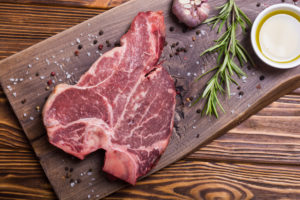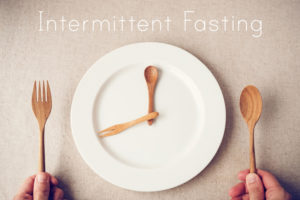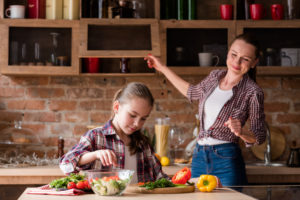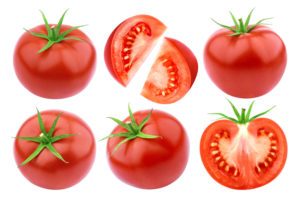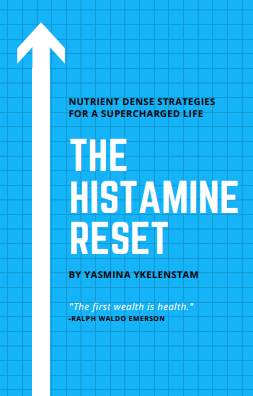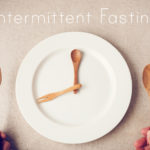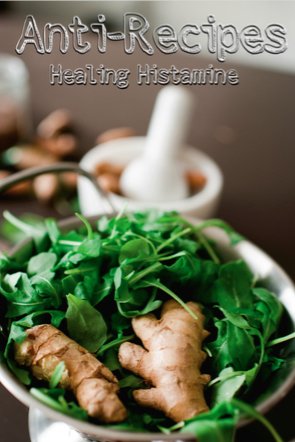
Bacteria cause histamine release in the body, so it makes sense to cook from scratch daily.
Doesn’t it?
Does eating fresh food devoid of leftover bacteria free up some of my histamine allowance for something more fun, like a raw cacao brownie?
Hells ya.
Read more about spending your histamine allowance here.
But do I have time to slave at the stove three times a day?
I can’t bring myself to actually use an emoticon in a blog post so please do me a favour and visualise an angry yellow frownie face simultaneously crying and stabbing a pot roast with a pitchfork.
Now we’ve established that most of us have neither time nor energy to make food our life, here’s some kitchen hacks I recently shared in my two hour online workshop: beyond the low histamine diet.
Time saving kitchen tips:
Make soup in bulk
For nine months of the year I live on soup. I don’t bother making stock, the veggies are the stock. Just bung them all into the pot, cover with water, add in onion and garlic and boil. You can get fancy, or just make some simple ones like the green soup in the Anti-Cookbook or the Anti-Detox. It’s a pretty amazing soup which has14 antihistamine and anti-inflammatory ingredients.
I usually make two soups a week and freeze them into individual tupperware or ziplock bags. I’ll stick the soup in hot water to quickly defrost it.
Bulking beans
I use the same technique for beans. Cook in quantity and then freeze into individual servings. When needed take them out of wrapping and then pop in boiling water for a minute and then add to salads or roast/whatever.
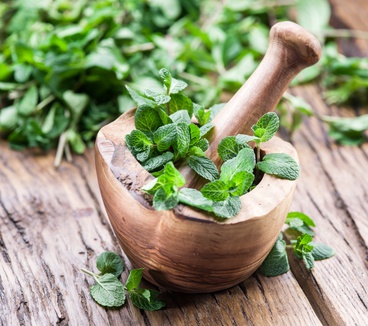
Herb cubes
As you may have heard, I’m big on herbs. They’re full of lovely ingredients like chlorophyll (great for helping produce red blood cells), as well as the bioflavonoids quercetin and luteolin, which possess antihistamine and anti-inflammatory properties.
So I pop some garlic, onion, herbs and olive oil into a blender and then pulse till getting a pesto-like texture. Pour them into ice cube trays, freeze and presto – the hard stuff is done. Just add a couple of cubes to soups, stir fry, or anything really.
I don’t know of anything that doesn’t benefit from a little (or a lot in my case) greenery, even fruit (but you might want to omit the alliums in this case).
Baked goods
Two ways to go here. One is to pour the batter into the moulds if making something like muffins or brownies in bulk and then pop the tray, unbaked, in the freezer and then cook from frozen later.
The other is to bake, then place in foil and freeze into individual portions. When you’re hankering for a treat, keep the baked good in the foil and place in a pre-heated oven till cooked through again. As an example, one of the muffins from the free ebook the Little Book of Muffins would normally take 10-15 mins to bake.
Freeze pancakes and flatbreads
You’ll find a recipe for one of my favourite gluten and grain free flatbreads here and pancakes here. Basically all you have to do is make in bulk and then freeze. Just add some baking paper between each one (you can recycle this paper from batch to batch). For the both I don’t recommend cooking them all the way through before freezing. You may want to dampen the flatbread with a little bit of water before placing it in the oven.
If you make the pancakes about the circumference of a mug you can then cover them in foil and pop in the toaster. I learned the hard way that foil upsets the microwave, basically by blowing up the one in my college dorm, so please don’t replicate my stupidity.
Freeze vegetables
Roasted veggies freeze really well. Just place them in foil before doing so. I serve these with a side of protein or use them to top off a salad. Add a herb cube to the roasting process of course!
Defrosting meat
I place it in a large pot, still in its packaging and then cover the packet with lukewarm water.
Leftover strategies
Freeze immediately into ziplock bag or foil, depending on consistency. To defrost: use lukewarm water on the former and loosen the foil on the latter and then place in the oven. (Or remove from foil and place on a baking tray).
Other time saving strategies:
Please don’t attempt these if suffering from brain fog or generally forgetful. If in doubt, as your partner or kids if you are!
1. After cooking I fill up the sink with water and pile in all the dishes to soak while I go live my life till the next meal. Next time I’m in the kitchen to cook, I’ll chop everything up, get all the pots and pans ready and toss in everything to be sautéed. While the veggies are cooking (on low heat of course) I’ll turn around and start washing the dishes or putting them in the dishwasher. Once finished cooking, the cycle begins again with a new sink o’ suds. I don’t wash everything, just a few things and then attend to the cooking and then back to the dishes. I also clean up and wash up as much as I can of whatever I’m using to make that meal.
It sounds hectic but you get into the rhythm of it…
2. I pre-heat the oven before I do anything else, and then, because I know exactly how long my food takes to cook and because I have a timer that switches off the oven, I’ll go take a shower or do some work at the kitchen counter while waiting.
For safety reasons I absolutely do not recommend doing this – I’m just sharing what I do at home. If brain fog is an issue in the slightest, or if you’re not 100% sure of proper cooking times, then this is obviously a terrible idea.
3. Chop veggies and herbs in a blender/food processor. Most kitchen machine thingies have a pulse option for chopping. This is a HUGE time saver. You can pick up something like this for as little as $20.
4. When I’m seriously time poor I’ll make a week’s worth of juice and then freeze it into sports bottles. I’ll take one out on the road with me without defrosting and let nature take its course, but you can absolutely use a warm water bath to speed up the process. Yes, I know, most people are totally anti-juices that aren’t just freshly squeezed. I do what I have to and trust that there’s nutrients in there. I do not however drink the juice cold…
5. Shop online. This is such an incredible time saver as well as an option that really helps with will power. It’s hard to buy what you don’t see and some stores give you the option of saving a shopping list to buy weekly. A new online market called Thrive has pretty wonderful prices compared to buying organic in most other places and you should definitely consider joining a local co-op.
6. Buy from farmers directly. If you’re lucky enough to live in an area with farms, go ahead and reach out to them to see if you can cut out the middle man. If you have nice neighbours see if they’re interested in splitting a side of beef with you. You’d be surprised…
7. Buy in bulk. If you see a deal, go for it. You can chop fruit, vegetables and herbs up and freeze them.
8. Buy frozen. Some studies show that freezing preserves the nutrients which might otherwise die out when the product is in transit or sitting in your fridge. Organic fruit and veggies are much cheaper frozen.
And finally, if on a budget, consider buying the foods most affected by pesticides, the so-called “dirty dozen”, organic instead and everything else conventional.
Please share your favourite kitchen and money saving hacks below.
Lotus also contains quercetin and rutin, two of the mast cell stabilising bioflavonoids found in the supplement I take daily. Stabilising mast cells may stop them releasing inflammatory molecules like histamine, prostaglandins and others, which is useful to those with inflammatory conditions like histamine intolerance, mast cell activation and others.
You’ll find recipes full of foods with antihistamine and anti-inflammatory properties my books Anti-Recipes and The Anti-Cookbook
CLICK HERE TO CREATE YOUR OWN PERSONALISED HEALING HISTAMINE PLAN.


